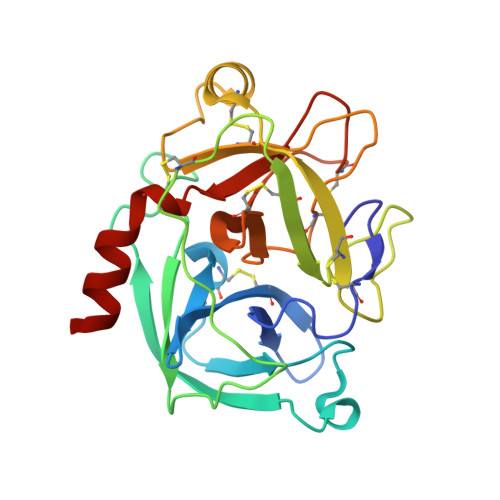Crystal structures of human tissue kallikrein 4: activity modulation by a specific zinc binding site.
Debela, M., Magdolen, V., Grimminger, V., Sommerhoff, C., Messerschmidt, A., Huber, R., Friedrich, R., Bode, W., Goettig, P.(2006) J Mol Biol 362: 1094-1107
- PubMed: 16950394
- DOI: https://doi.org/10.1016/j.jmb.2006.08.003
- Primary Citation of Related Structures:
2BDG, 2BDH, 2BDI - PubMed Abstract:
Human tissue kallikrein 4 (hK4) belongs to a 15-member family of closely related serine proteinases. hK4 is predominantly expressed in prostate, activates hK3/PSA, and is up-regulated in prostate and ovarian cancer. We have identified active monomers of recombinant hK4 besides inactive oligomers in solution. hK4 crystallised in the presence of zinc, nickel, and cobalt ions in three crystal forms containing cyclic tetramers and octamers. These structures display a novel metal site between His25 and Glu77 that links the 70-80 loop with the N-terminal segment. Micromolar zinc as present in prostatic fluid inhibits the enzymatic activity of hK4 against fluorogenic substrates. In our measurements, wild-type hK4 exhibited a zinc inhibition constant (IC50) of 16 microM including a permanent residual activity, in contrast to the zinc-independent mutants H25A and E77A. Since the Ile16 N terminus of wild-type hK4 becomes more accessible for acetylating agents in the presence of zinc, we propose that zinc affects the hK4 active site via the salt-bridge formed between the N terminus and Asp194 required for a functional active site. hK4 possesses an unusual 99-loop that creates a groove-like acidic S2 subsite. These findings explain the observed specificity of hK4 for the P1 to P4 substrate residues. Moreover, hK4 shows a negatively charged surface patch, which may represent an exosite for prime-side substrate recognition.
Organizational Affiliation:
Max-Planck-Institut für Biochemie, Proteinase Research Group, Am Klopferspitz 18, 82152 Martinsried, Germany.


















